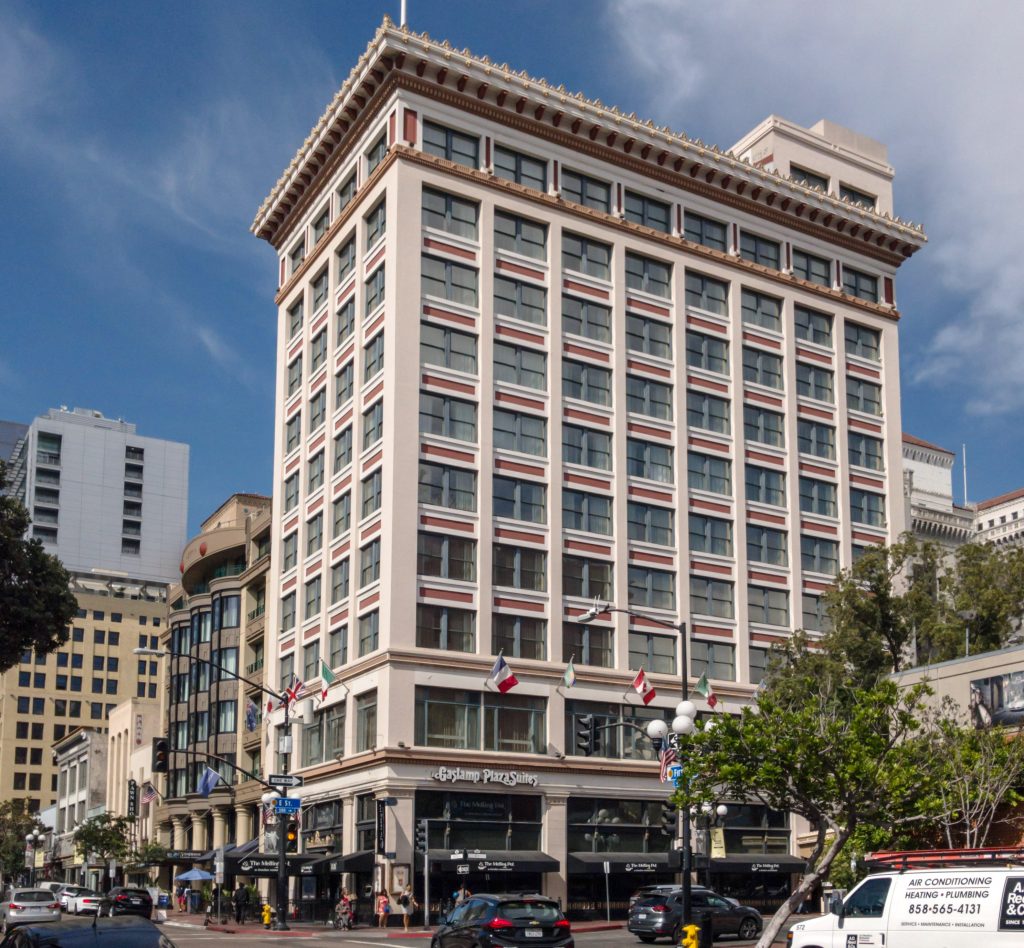Landmarks
Reaching for the Stars
The Watts-Robinson Building
1913
Northeast Corner of 5th and E Street
Architects: Leonard T. Bristow & John B. Lyman, Jr.
Architectural Style: Romanesque Revival
Some buildings naturally take your breath away, but the interiors turn out to be less stellar. Others are largely utilitarian on the outside but are quite lovely on the inside. The Watts-Robinson, San Diego’s first Chicago-style skyscraper, is both. I am, of course, referring to the second Watts-Robinson building. Although the first building was no slouch, it could not rival the elegance and splendor of the second structure.
Early owners of the lot were Judge Charles B. Richards, later director of the San Diego Savings Bank and Dr. Thomas C. Stockton, the physician who assisted Nurse Anna Scheper at the Davis-Horton House. By 1885, the property was owned by Robert Johnson, who set about constructing the first building at the site. It consisted of a 48’ frontage on 5th and an 80’ frontage on E St. The first floor was divided into two large stores with the upper floor divided into eleven offices. Unfortunately, Mr. Johnson became ill and passed away before his project was finished. All of his property was sold after probate and the new owner was Henry Watts.
Mr. Watts continued to rent out the upper floors as offices, while half of the ground floor now housed a wholesale liquor store and the other half served as a grocery store. The land boom of the 1880s encouraged real estate speculation, and several real estate offices also opened in the building.
Although business was booming, Mr. Watt’s health was apparently suffering, and he passed away on February 25, 1889 at the Florence Hotel. His estate passed to H.C. Watts. Under Watts, a different type of clientele occupied the building. They included dentists, the Postal Telegraph Company, and a theosophist. Upon his death in 1889, his son Nathan, a real estate agent, took over the building. Nathan rented to a variety of clients and opened the building to several service firms, including the Chicago Barber Shop, a photographer’s studio, and the Blockman Banking Company.
By 1912, Nathan aspired to something grander. He demolished his 26-year- old building to make way for an imposing eleven story building in the style of the Chicago School of Architecture. The projected structure would have ten stories above the ground and two below. The basement excavation alone cost $4,557, with the building contractor, the F.O. Engstrom Company, receiving $142,000. The Thomas Haverty Company was the plumber and charged the sum of $18,446, while the Van Emon Elevator Company received the bid for installing elevators for $297,000.
The depth from the street level to the footings was 35 feet making it the deepest of any business in the city. The sub-basement housed all the building machinery, which included the boiler room, vacuum cleaning system, compressed air plant and elevator apparatus. The San Diego Savings Bank secured the entire basement and first floor, as their new banking quarters.
The building was of steel reinforced concrete and hollow tile. The exterior was finished with cut limestone and granite and cement plaster.
The 130 offices above the first floor were equipped with hot and cold water and special waste outlets. Additionally, there were compressed air, gas and electric outlets for the use of doctors and dentists. Additional amenities included steam heat, mail chutes, vacuum cleaning systems and two high speed elevators with uniformed attendants. The interior corridors were wainscoted with white marble and Australian gum-wood and featured tiled floors. The halls and offices were well lighted and ventilated.
The San Diego Savings Bank opened its doors on November 22, 1913, although the date of completion is listed as December 11, 1913. Thousands of visitors thronged the magnificent new headquarters of San Diego’s foremost financial institution, which stayed at this location until 1927.
In 1926, Nathan Watts died and his sister, Pauline Watts Settle, a prominent socialite, took over the property. It was her father-in-law, a judge, who nominated General Ulysses S. Grant for the Presidency. She remodeled the building in 1937 after the Depression, adding more marble and new elevators. In 1944, Mrs. Settle sold the property to Isadore, Betty, Abraham and Florence Tamara Teacher. Isadore was a jeweler, which very likely influenced the many jewelers consequently occupying the building. The teachers were a very colorful family. Isadore was acquitted of charges of receiving stolen goods, but later convicted of income tax evasion. He received a full pardon from President Dwight D. Eisenhower in 1960. His sister, Florence Tamara, did not fare so well. She was murdered in her home in Mission Hills in 1976.
By 1951, the Watts Building had once more changed hands. It was sold to Joseph H. Norman, a broker from Texas and California. He promptly turned the property once again, and the new owners were a group of attorneys from San Francisco, led by a Mr. Robinson. It now became the Watts-Robinson Building, the name by which it is now known. The structure continued to house doctors, lawyers, jewelers, photographers and importers.
The building continued to change hands throughout the ensuing years until 1988, when the Gaslamp Plaza Suites opened as an elegant 60-suite hotel. The Gaslamp Plaza Suites remains and was joined by the Melting Pot Restaurant.
Many of the original architectural aspects are still evident, including the marble wainscoting, elaborate ceilings, brass elevator doors, gum-wood carpentry and etched glass windows and doors. They provide an echo of slower, more elegant and formal times.
Sandee is the historian for the Gaslamp Quarter Historical Foundation. She can be reached at [email protected].

